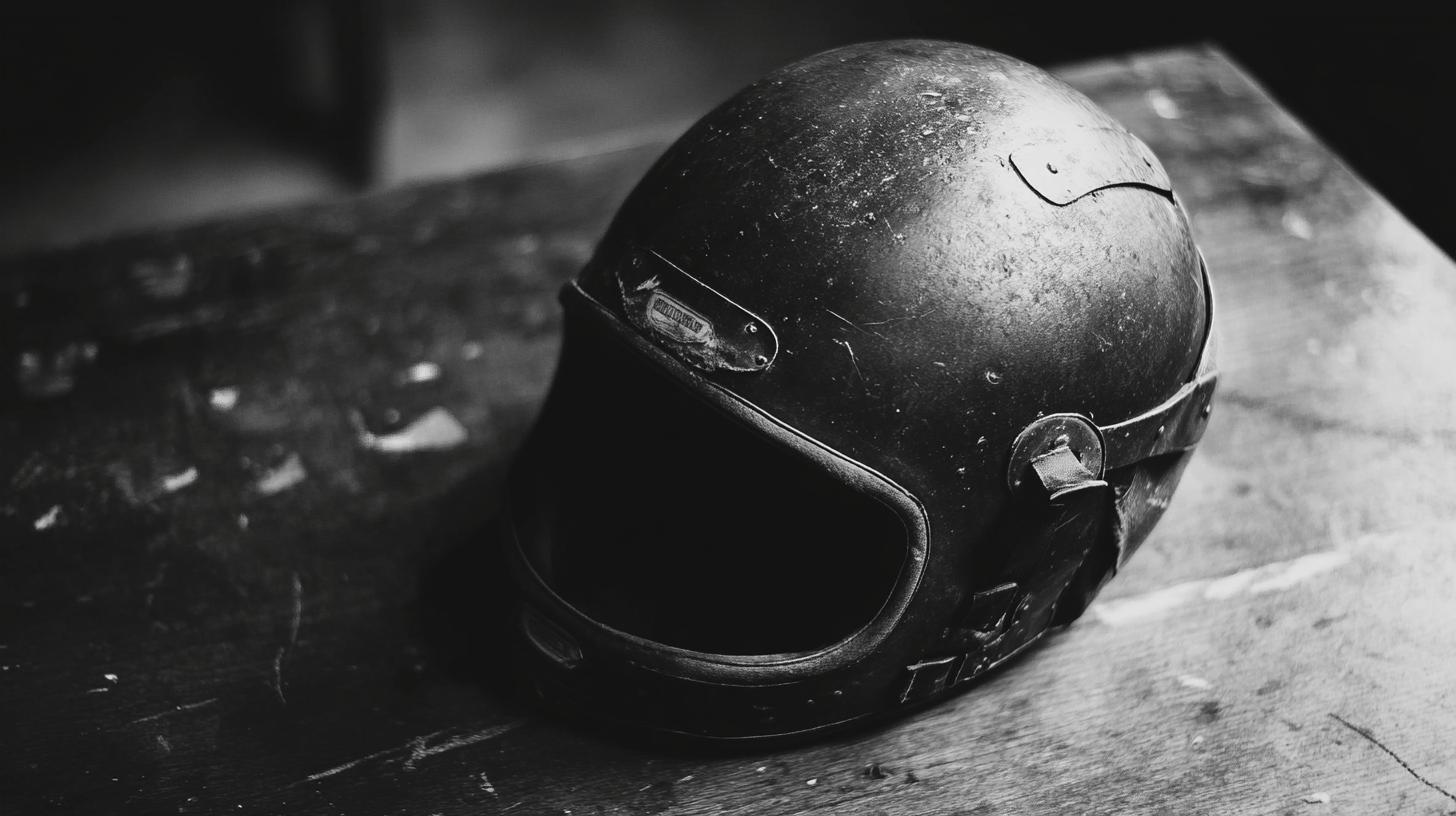Ever wondered when the iconic motorcycle helmet first made its debut? Journey back to 1914, a year that marked a seismic shift in motorcycle safety with the introduction of the first protective helmet.
This early innovation represented a pivotal milestone, spotlighting the burgeoning focus on rider safety. As motorcycling gained popularity, the need for enhanced protection became undeniable, setting the stage for future advancements.
Explore how a simple yet groundbreaking design set off a chain reaction in safety innovation, ultimately transforming motorcycling from a perilous pastime to a safer pursuit.
Invention of the First Motorcycle Helmet

When were motorcycle helmets invented? The first motorcycle helmet made its appearance in 1914, marking a significant milestone in rider safety. This invention was primarily driven by the need to protect motorcyclists from head injuries, which were becoming increasingly common as motorcycles gained popularity.
The early 1900s helmet design was rudimentary compared to today's standards, but it represented the initial acknowledgment of the inherent risks involved in motorcycling. This innovation set the stage for future developments in safety gear, emphasizing the necessity of head protection for riders.
The introduction of the motorcycle helmet in 1914 had an immediate impact on the safety of riders. Although the design was basic, it provided a newfound level of security that was previously unavailable.
This early helmet was crafted with the primary goal of mitigating the severity of head injuries during accidents. By focusing on rider safety, the invention underscored the importance of protective gear, paving the way for subsequent advancements in helmet technology.
-
Constructed with basic materials aiming for impact absorption
-
Offered enhanced head protection compared to no helmet
-
Initiated the concept of safety gear for motorcyclists
Early Developments in Motorcycle Helmet Design

When did early motorcycle helmets become a crucial part of rider safety? The significance of helmets was starkly realized in 1935 with the tragic death of T.E. Lawrence, famously known as Lawrence of Arabia.
This incident highlighted the dire need for improved head protection for motorcyclists, marking a pivotal moment in the origins of motorcycle helmets. Lawrence's death served as a catalyst for recognizing the life-saving potential of helmets, prompting a shift towards prioritizing rider safety through innovative gear.
The period following Lawrence's accident saw a burgeoning interest in developing more effective biker safety gear. The years after World War II were particularly transformative, as specialized helmet manufacturers began to emerge. Companies like AGV, founded in 1947, took significant strides in helmet design, setting new benchmarks for safety and comfort.
These early innovations laid the groundwork for a new era of helmet manufacturing, emphasizing the necessity for protective headgear tailored to the unique demands of motorcycling.
Innovation in biker safety gear continued to gain momentum as helmet designs evolved. The post-war period was characterized by a focused effort to enhance the protective features of helmets, driven by a deeper understanding of rider safety needs. This era saw the introduction of more durable materials and refined design elements, which contributed to the improved performance and reliability of helmets.
As a result, the advancements made during this time played a crucial role in shaping the future of motorcycle helmet technology, ensuring that rider safety remained at the forefront of design priorities.
Evolution of Helmet Technology and Materials

Motorcycle helmets have evolved dramatically from their early days, where simple leather caps offered minimal protection. These initial designs were primarily crafted from leather, which provided basic abrasion resistance but lacked the ability to absorb significant impact. As the understanding of rider safety deepened, so did the need for more effective materials and designs.
Material Innovations
The evolution of helmet materials marked a significant leap in rider protection. The introduction of fiberglass in the mid-20th century was a game-changer, as it provided a lightweight yet sturdy option that could better absorb impacts. By the late 20th century, materials like carbon fiber and Kevlar composites became prevalent.
These advanced materials significantly enhanced helmet safety due to their superior strength-to-weight ratio and impact resistance. Carbon fiber, known for its lightweight properties, allows helmets to maintain structural integrity during collisions, while Kevlar adds an extra layer of durability and puncture resistance.
Design Breakthroughs
A pivotal advancement in helmet design came in 1967 when AGV introduced the first full-face helmet, revolutionizing rider protection. This design enclosed the entire head, providing comprehensive coverage that significantly reduced the risk of facial injuries during accidents. Full-face helmets also improved aerodynamics, making rides smoother and reducing wind noise.
Over the years, comfort has become a crucial focus, with features like ventilation systems and adjustable padding enhancing the rider's experience. These innovations have made helmets not only safer but also more user-friendly.
| Era | Materials Used | Impact on Safety |
|---|---|---|
| Early 1900s | Leather | Minimal protection, basic abrasion resistance |
| Mid-20th Century | Fiberglass | Improved impact absorption, lightweight |
| Late 20th Century – Present | Carbon Fiber, Kevlar | Enhanced strength-to-weight ratio, superior durability |
The Role of Helmets in Motorcycle Safety

How do helmets impact motorcycle safety? Helmets play a pivotal role in reducing injuries and fatalities among motorcyclists. Research consistently demonstrates that wearing a helmet significantly decreases the risk of head injuries during accidents. A helmet's primary function is to absorb impact energy, thereby reducing the force transmitted to the skull and brain.
This capability is crucial in preventing traumatic brain injuries, which are often life-threatening or result in long-term disabilities. By effectively minimizing impact, helmets are a fundamental component of rider safety.
What evidence supports helmet effectiveness? Numerous studies back the effectiveness of helmets in safeguarding riders. Data from traffic safety organizations reveal that helmeted riders are substantially less likely to suffer severe head injuries in crashes compared to those without helmets. For instance, helmets reduce the risk of head injury by about 69% and the risk of death by 42%.
These statistics highlight the indisputable value of helmets in enhancing rider protection. Furthermore, ongoing research and technological advancements continue to improve helmet design and materials, further bolstering their protective capabilities.
How have safety standards evolved for helmets? Over the years, safety standards and regulations for helmets have evolved, reinforcing their protective features. Organizations like the Department of Transportation (DOT) and the Economic Commission for Europe (ECE) establish stringent criteria that manufacturers must meet to ensure helmets provide adequate safety.
These standards cover aspects such as impact resistance, retention system strength, and field of vision. Compliance with these regulations ensures that helmets offer a high level of protection, making them indispensable for motorcyclists worldwide.
-
Reduce risk of head injury by 69%
-
Lower risk of death by 42%
-
Absorb impact energy effectively
-
Meet stringent safety standards
-
Continually improve through research and innovation
Helmet Adoption and Cultural Impact

When did helmet adoption become widespread in motorcycling culture? Helmet adoption became widespread as safety awareness increased, largely due to structured safety campaigns and legislative measures.
Over the decades, the cultural acceptance of helmets has grown considerably, influenced by the undeniable evidence of their protective benefits. Initially, helmets were met with resistance, as many riders perceived them as uncomfortable or restrictive. However, as more data emerged highlighting their life-saving capabilities, societal attitudes began to shift.
Campaigns promoting helmet use have played a crucial role in changing perceptions, positioning helmets as an essential part of motorcycling culture.
How have policies influenced helmet usage? Legislative measures have been instrumental in increasing helmet adoption rates worldwide. Many countries have implemented laws mandating helmet use, recognizing their efficacy in reducing injuries and fatalities.
These laws vary in strictness and enforcement but have generally contributed to higher compliance and acceptance among riders. The imposition of helmet laws has not only enhanced rider safety but has also helped normalize helmet use, embedding it into the fabric of motorcycling culture.
Through these policies, helmets have transitioned from optional gear to a standard requirement, underscoring their significance in protecting motorcyclists.
-
Introduction of helmet laws in the 1970s increased usage.
-
Safety campaigns in the 1980s emphasized helmet benefits.
-
Celebrity endorsements helped destigmatize helmet use.
- Research linking helmets to reduced fatalities bolstered acceptance.
Final Words
The journey of motorcycle helmets began in 1914, providing much-needed head protection, forever changing rider safety. Significant events, including T.E. Lawrence's accident, spurred innovations in design, while manufacturers like AGV paved the way for technological advancements.
Over the decades, materials evolved, with carbon fiber and Kevlar enhancing protection. Helmets have proven crucial in reducing injuries and, through growing cultural acceptance, have become deeply rooted in motorcycling culture. When were motorcycle helmets invented? The impact since their inception reflects the ongoing commitment to rider safety.
FAQ
When were motorcycle helmets invented in the USA?
Motorcycle helmets were invented in 1914 in the United States to enhance rider safety.
When was the first helmet used in sports?
The first helmet used in sports appeared around the same time as motorcycle helmets but became more common as safety awareness increased.
When were motorcycle helmets made compulsory?
The compulsory use of motorcycle helmets began in various regions during the 1960s and 1970s as safety regulations were enacted.
What is E13 helmet certification?
E13 helmet certification refers to specific safety standards, ensuring that helmets meet required safety criteria in certain countries.
What is the oldest helmet brand?
The oldest motorcycle helmet brand known is Arai, established in 1909, consistently innovating in safety gear.
When was the first helmet invented?
The first protective helmet was developed for industrial use in the early 1900s, leading to various adaptations for different activities.
Why do motorcycle helmets only last 5 years?
Motorcycle helmets are recommended for replacement every five years due to material degradation and to maintain optimal safety standards.
When did people start wearing helmets on motorcycles?
Motorcyclists began wearing helmets consistently in the mid-20th century, driven by increasing safety awareness and regulations.
What is the origin of HJC helmet company?
HJC Helmets, founded in 1971 in South Korea, focuses on creating innovative and safe motorcycle helmets worldwide.

Brad Mitchell is a seasoned motorcycle enthusiast with over 16 years of riding experience. He’s spent countless hours on the open road, particularly favoring scenic routes aboard his trusted Harley-Davidson. Brad’s laid-back approach to life and riding gives him a unique perspective on motorcycle gear and safety, which he shares through his in-depth reviews and expert advice on ProtectiveGearz.



